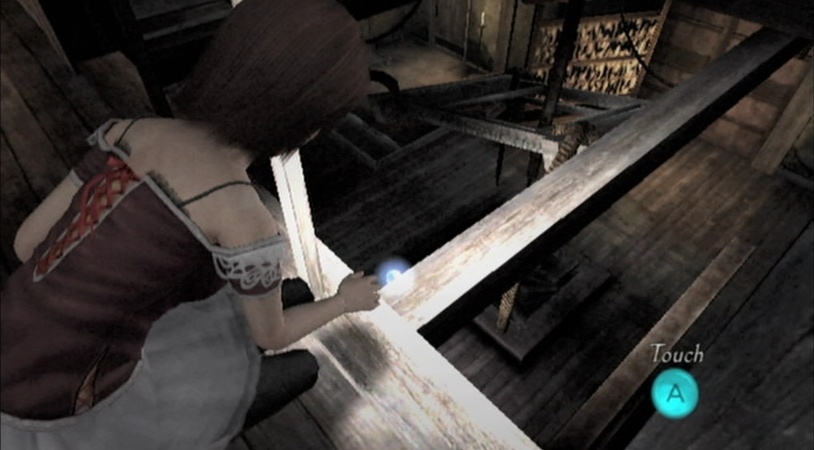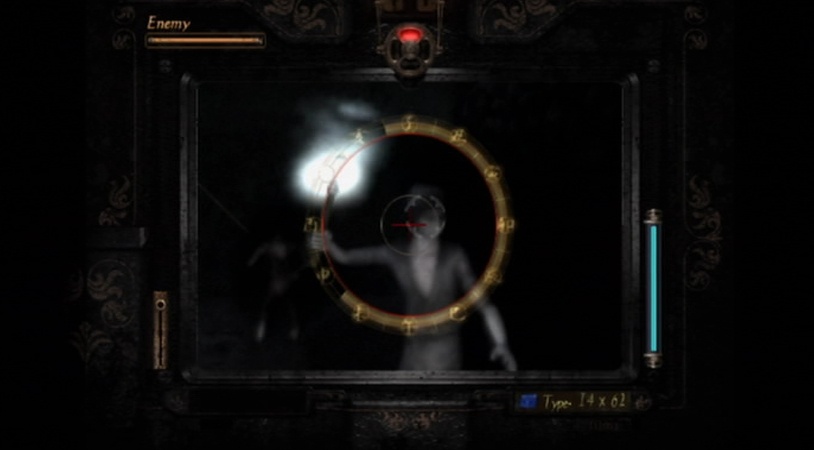UK REVIEW--Project Zero 2 is a remake of the disturbing Fatal Frame II: Crimson Butterfly, and it might be one of the Wii’s finest retreads--it’s certainly one of its scariest. Nintendo isn't averse to a touch of horror, but Project Zero 2 is a far cry from the excesses of Resident Evil, and even the Lovecraftian menace of Eternal Darkness. Instead, it offers something altogether bleaker: a brutally intense and unsettling tale of ritualistic sacrifice, murder, and tormented spirits. The game is unrelentingly grisly to the point where you'd be hard pressed to say it's enjoyable to play, but it's incredibly gripping and genuinely frightening.
The narrative setup is fairly well-worn in the horror genre: twin sisters Mio and Mayu find themselves in an abandoned village with a mysterious secret that must be solved before they can escape. The two are separated, and though Mayu frequently appears to her sister, she always seems to be out of reach. While everything about the place should set off a warning alarm telling her to turn and run, Mio blindly follows her sibling, stumbling into a series of terrifying encounters with the wandering spirits that haunt the village.
It's a disturbing place even before the ghosts show up--a dilapidated, dimly lit settlement of cramped interiors and sinuous pathways. As in the original game, the fear factor is slow to build, the game holding back the shocks and ratcheting up the tension to near-unbearable levels.
Where the original used static camera angles, this adopts Fatal Frame IV's over-the-shoulder perspective, restricting you to an incredibly narrow field of view that only heightens the sensation that something terrible lies just out of sight. It also includes the exquisitely nerve-racking "touch" mechanic from the same game, where you have to hold the A button to have Mio gradually extend her arm to pick up an item, open a drawer, or lift an object to discover what's underneath. A further carryover is the sporadic appearance of a spectral hand, which will occasionally grab Mio's arm: these moments might seem like cheap jolts next to the constant atmosphere of creeping dread, but they're used infrequent enough so as not to undermine the scares when they do arrive.
Indeed, basic actions like opening doors or peering around corners are transformed by a more dynamic camera, which leans in closer, sometimes tugging you over Mio's shoulder to a near first-person perspective, forcing you into rooms before the character you're controlling. That the vast majority of the time there's nothing there only makes the surprises more potent. It's quite an achievement to turn the simple act of holding a button into a test of nerve: the game dares you to be brave and then provokes a genuine sensation of relief when nothing emerges.
It's not long before they do, mind you. Many of the ghosts have backstories, their tales sketched out through discarded notes and fragments of diary entries: tragic, but no less frightening. Some ghosts drop spirit stones in which their thoughts are vocalised; you can slot them into a strange radio and hear their wails through the remote's speaker, the tinny sound quality only making them more unnerving. Others are even scarier, unexplained horrors that float, stumble, and lurch unnaturally toward you, limbs and faces horribly contorted.
Of course, the wonderfully sadistic idea at the heart of the game's systems is that you're actively encouraged to let these malevolent spirits get as close as possible. The camera obscura you wield deals damage as it captures their image, with collectable lenses and upgrades allowing you to temporarily stun or push back your ectoplasmic aggressors. You inflict significant damage when the shutter flashes red for a fatal frame, while bonuses are awarded for snapping two and three ghosts simultaneously.
While the floating numbers and text remind you this is just a game, they never sap the intensity of these encounters. That's partly down to the very deliberate awkwardness of the controls, which regularly prove uncomfortable. Aiming requires a combination of the nunchuk's analog stick and tilts of the remote, which may sound clumsy, and in practice it often is. Yet it's an artful clumsiness, designed to make combat more difficult and thus more unsettling. If the camera obscura were an SLR, then you'd breeze through encounters; here, the controls fit the fiction and serve the game's systems well.
And just as you grow accustomed to negotiating combat scenarios without too much difficulty, the game disempowers you further. You're rid of your torch, forced to explore rooms lit only by the occasional lightning flash and the faint glow of a single lantern. Ghosts begin to move faster, and then suddenly disappear, teleporting behind you. The inclusion of a quick turn is welcome, though it's still startling to whirl around, raise your camera, and instantly witness a screaming face filling your viewfinder.
Most chapters find new ways to terrify. You encounter deadly spirits that can't be harmed by the camera, forcing you to flee. You're teased with images of rooms you're about to visit, steeling you for the horrors that inevitably lie in wait. One particularly disturbing set piece sees you suddenly surrounded by corpses while a ghost shrieks with laughter before an invincible spirit with a deathly touch forces you to flee. That Mio runs at the pace that most game characters walk only makes your escape more fraught. Other moments offer subtler scares: there's a masterful fourth-wall-breaking sequence that puts you in a room with an old projector--the Wii's disc drive whirring in time with the spinning reel--and suddenly stopping as the film ends. Along with the voices of the spirits floating from the TV to the remote's speaker, it can sometimes feel that the horror is seeping into the real world.
If the Wii version is mostly an improvement on the original game, it does suffer in other areas. The perspective shift can result in camera problems in narrow spaces, and while Nintendo has put laudable effort into localising the game for a European audience, the British voices aren't a great fit for the Japanese setting. The performances are also a little flat compared with recent translations like The Last Story and Xenoblade Chronicles. And though the game works hard to make you feel uneasy, the revealing attire of its 15-year-old protagonist and the camera's willingness to highlight her flimsy clothes is the wrong kind of uncomfortable.
The only other notable addition is a new Haunted House mode, an on-rails scare ride that sees you exploring a series of locations unlocked by playing through the campaign. You might be asked to take pictures of spirits or simply remain calm in the face of some rather corny jump-shocks by keeping the remote still before being judged on your performance or stoicism. It's essentially a rather brazen copy of the Ju-On game, and while it's fleetingly entertaining, it's not a mode you'll revisit too often.
Thankfully, the story is more than worth the price of admission, and it's a reminder why horror games can be so intoxicating. Break Project Zero 2 down to its base mechanics, and you're left with something that is by turns awkward and embarrassingly simplistic: its puzzles are rudimentary, and it's as linear as games can get. But its claustrophobic atmosphere and masterful sense of pacing generate a pervasive sense of dread that immerses and consumes you. At one point, you come across a room with bloody handprints on the adjacent wall and smeared across the door, not wanting to enter, but knowing you have to. It's these excruciating moments of anxious anticipation that make Project Zero 2 one of the scariest experiences you'll encounter in any medium.
'

